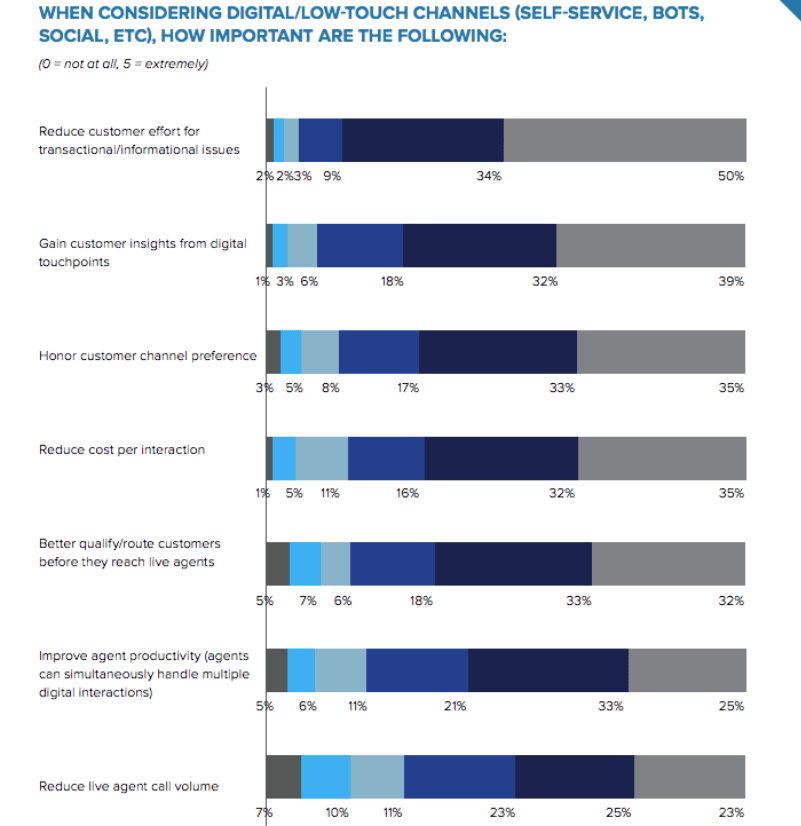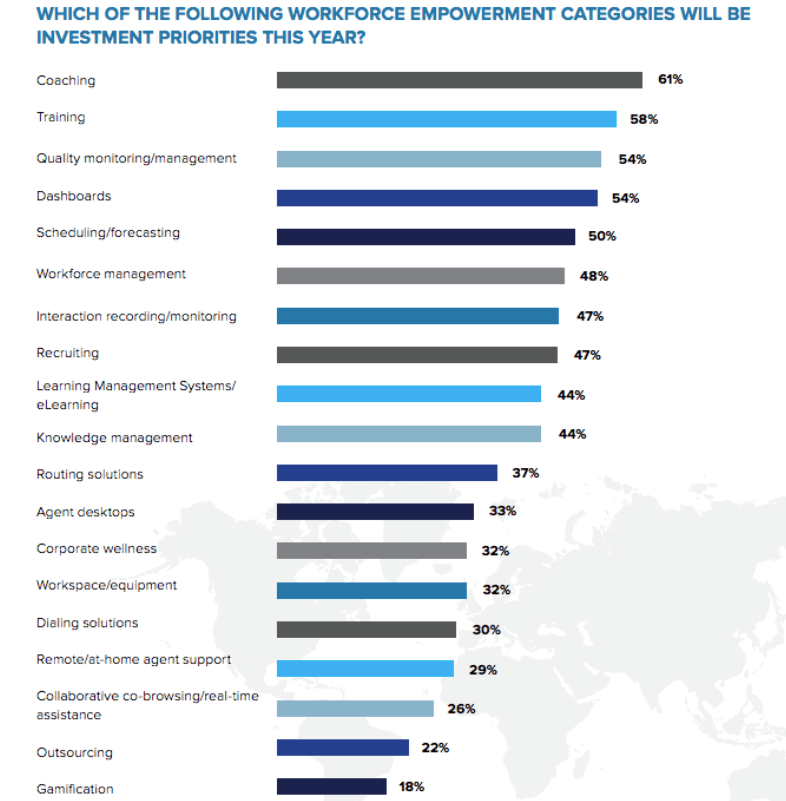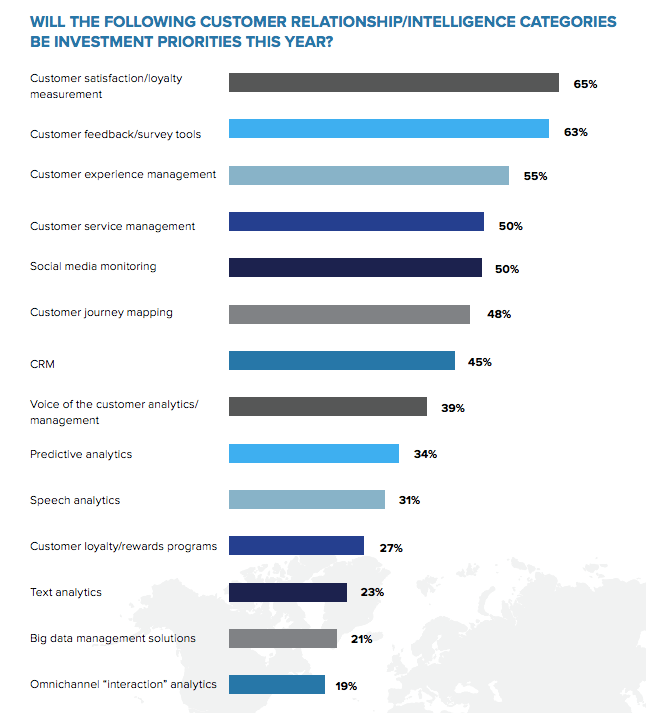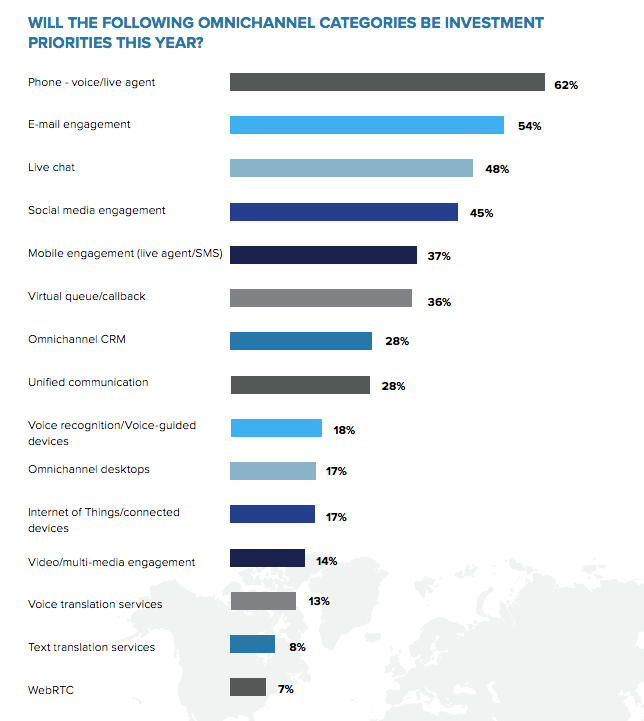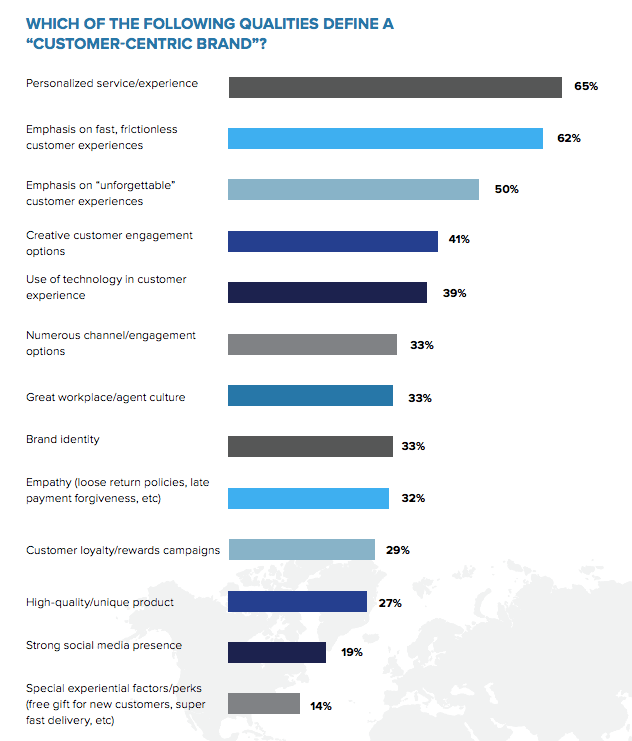2018 is just around the corner, which means that companies around the world are planning (or have already planned) their business goals for next year. For many organizations, a huge part of this new year task is setting contact center priorities — priorities that can have a colossal impact on the customer experience.
But deciding on annual goals and specific yearly focuses for a call center isn’t always easy. With technologies and consumer demands constantly evolving, what unconditional priorities can companies set for their contact center that won’t be shattered by ever-changing standards?
CCW Digital, in their latest Winter Executive Report, studied a wide range of organizations to discover the most popular goals and strategies for call centers in 2018. Out of the organizations surveyed for the report, 49% generate over one billion dollars in annual revenue, and 72% have multiple contact center sites.
We’ve broken this report down so that no matter what stage your business is at in setting your annual priorities, you can learn what key goals other organizations hope to pursue (or continue pursuing) for their contact centers in 2018, and why they matter.
Top Priorities for 2018
Here is a rundown of the top priorities for organizations going into 2018.
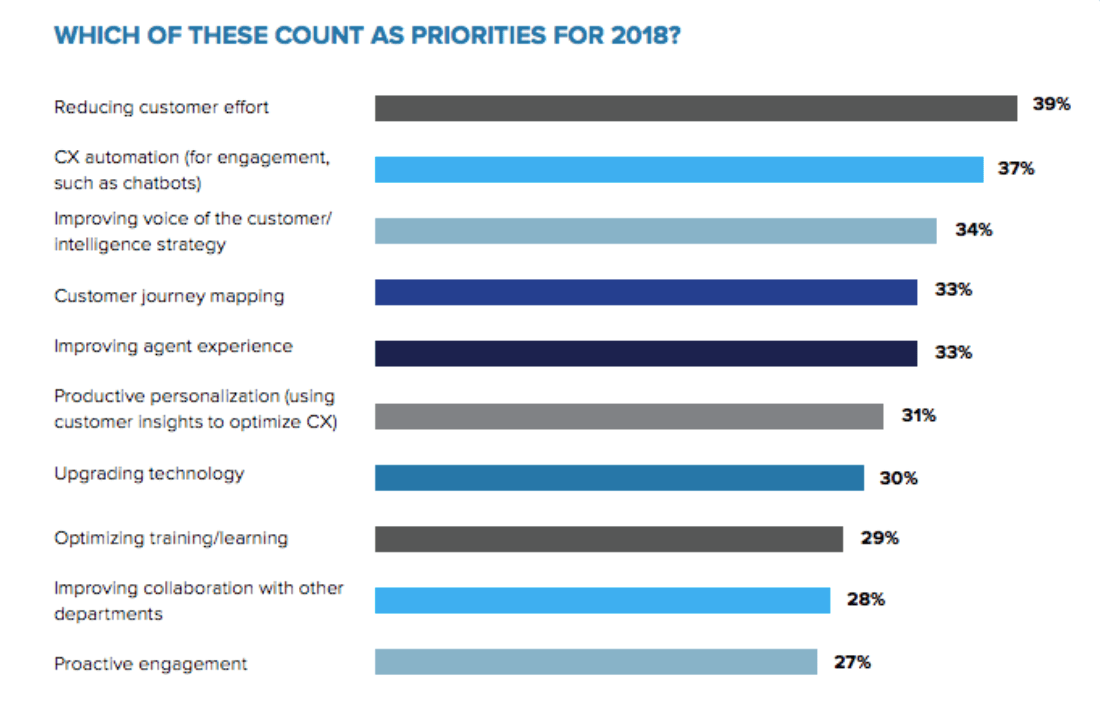
-
No Landslide Victories
If you’re reading this review to see what the one must-have contact center priority is for next year, you might be disappointed. What’s interesting about this report is that it finds that there is no one universal priority for 2018.
That doesn’t mean that there aren’t any top call center goals — it just means that no one priority took the lead by a landslide. The most pressing goals that organizations will be focusing on in 2018 come within percentage points of each other, and share a similar level of importance.
Tip: Designing annual priorities will be unique to each contact center, and may depend on company history, culture, and customer experience goals. As you read these findings, think about what is most true for your contact center.
-
A “Frictionless Experience” Is Top Priority
Reducing customer friction is the number one focus for organizations next year, with 39% of respondents aiming to prioritize this in 2018.
A “frictionless customer experience” (or FCX) is about one essential thing: removing transactional obstacles (aka friction) to make life easier for the customer.
The idea of a frictionless experience has been said by advocates and thought leaders to be “moving from novelty to mandatory.” By voting on reducing customer friction as the top goal for their contact centers, companies are showing that they agree.
Tip: Begin to examine your existing contact center processes. Where are your customers having a hard time? What can you do to make their experience faster – more efficient – more fluid?
-
Customer Experience Automation Is No.2 for Companies
With 37% of businesses vowing to focus on customer experience automation (in an engagement context) next year, it comes in as 2018’s second biggest customer contact priority.
This contact center priority goes hand in hand with the previous goal of reducing customer friction: by creating (or optimizing) an automated self-service experience, customers will be able to solve transactional self-service issues quickly and efficiently.
Tip: Invest in a Chatbot to help customers with everyday queries – for the best, most frictionless customer experience, make sure that customers can easily connect with a live chat agent should they find the automated assistance unhelpful.
-
Organizations Want to Improve the Voice of their Customer Strategy
The third most important priority to companies for 2018 is improving the voice of their customer strategy.
In order to improve the customer experience, companies must first deeply understand their customer base. This is why 34% of organizations have recognized the importance of improving their voice of the customer strategy: They want to be sure that the customer experiences that they are designing (and the investments that they are making) are what their customers are actually asking for.
Tip: Pay attention to customer demographics, culture, and feedback when crafting your customer engagement strategy.
-
Customer Journey Mapping Is Gaining Importance
One third of companies, or 33%, have prioritized improving customer journey mapping in 2018. This makes it the fourth most important goal for companies surveyed.
CCW Digital’s report notes, one reason for this is the trend of companies switching from a transactional approach to the customer experience to a relationship-driven one.
“As businesses increasingly recognize the customer experience as a ‘journey,’ they will naturally want to understand what that journey entails for customers,” says the report.
Customer journey mapping is another call center priority that ultimately serves the number one goal of creating a frictionless experience. Mapping the customer journey can help companies identify customer “pain points.” By examining these pain points, companies can begin to remedy them by removing snags from the buying process, and in doing so create a more valuable experience for customers.
Tip: Identify the touchpoints where a customer interacts with your organization (these could be major — such as starting a trial period, or minor, such as browsing your webpage). Visually map out the customer journey using these touchpoints. Examine where customers often abandon their journey, and how each touchpoint can be improved.
-
Improving the Agent Experience Ties for Fourth
Tied with customer journey mapping is improving the agent experience – a goal which also has 33% of company votes.
Improving the agent experience is beneficial to companies for several reasons. Agents that are happier can better care for customers, inspiring loyalty through quality service. Fulfilled agents also have a lower turnover rate (a common industry problem that saps companies’ precious time, resources, and affects customer care).
As the report puts it: “Agents, quite simply, are the gateway to a productive, customer-centric experience.”
Tip: Improve your agent experience through empowerment, and giving them tools to enhance their everyday lives.
Improving the Agent Experience: Examining Strategies
The organizations surveyed in CCW Digital’s Winter Executive Report all have similar top strategies for enhancing the agent experience. The bottom line is this: These strategies are about increasing agent contentment, motivation, and productivity by helping agents better perform their jobs.
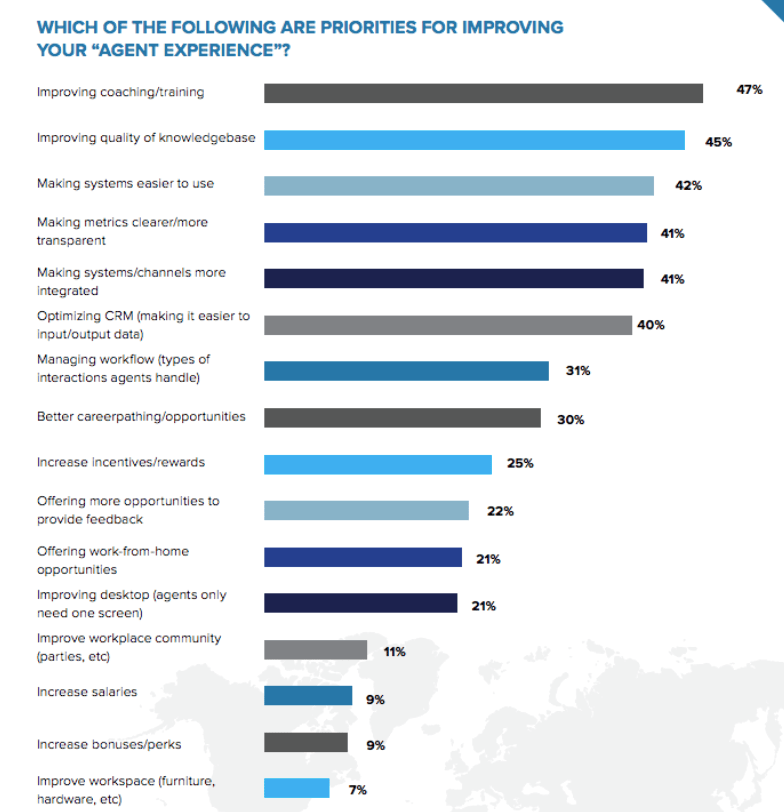
-
Nearly Half of Organizations Aim to Improve Agent Experience Through Training
For 48% of businesses, improving agent training and coaching is the number one strategy for creating a better agent experience in 2018.
Companies across the board believe that greater empowerment makes for a greater agent experience. Their preferred strategy for empowering (and therefore satisfying) agents is through better training and coaching practices.
Quality training and coaching programs provide agents with the knowledge, tools, and support that they need to be confident and succeed in their jobs. They show agents that the company is committed to their growth — now and in the future.
Improved training doesn’t only help agents: It helps customers as well. By giving agents access to better training and coaching, companies can improve the experience of two parties at once.
Tip: In the United States and United Kingdom, an estimated $37 billion is spent annually to keep unproductive employees who don’t understand their job. Create an agent onboarding program to support new hires, empower current employees, and prevent this loss.
Recommended for you: Do You Have an Effective Live Chat Onboarding Program? Here’s Why and How You Should Get One
-
Companies Want to Make Agents’ Lives Easier by Making Their Jobs Easier
Not only do companies want to improve agent experience by better preparing agents for the job — they also want to make agents’ lives easier by providing better aid for while on the job.
The second most popular agent experience initiative is improving the quality of their Knowledge Base — a strategy that 45% of organizations have on their plate for 2018. As the report so eloquently says: “Navigating the knowledge base is a fundamental part of the agent’s day-to-day role. By creating a more intuitive, efficient, effective knowledge process, organizations believe they can markedly impact the overall agent experience.”
Outdated and difficult systems are another part of agents’ everyday lives that can make their jobs harder, and affect happiness levels at work. That’s why making systems easier to use is the third most popular agent experience initiative (42%). By repairing broken systems that slow agents down and frustrate them, companies can remedy this common agent “pain point,” making their jobs easier and less stressful.
Making metrics clearer or more transparent is the next most popular corporate strategy for improving agent experience (41%). This is beneficial because when agents don’t know how they are performing or why, they lose motivation, and their experience suffers. Companies hope that by providing clear, real-time access to metrics, agents will be able to see tangible evidence of their contributions. This can help agents understand how they are being measured and become better self-starters, self-diagnosing and turning up their performance when need be.
Finally, 40% of companies vow to work on integrating channels for the sake of the agent experience. This is another strategy that improves both the agent and the customer experience: customers hate having to repeat themselves as they move between channels, and agents hate having to gather relevant information from irked customers. Integrating channels gives agents the data they need to aid customers, and makes customers happier and friendlier recipients of that aid.
Tip: Have an up-to-date knowledge base, and empower qualified agents by encouraging them to contribute (for example, by updating canned messages). Establish open communication channels between agents, management, and IT, in order to optimize the system and establish clear, visible metrics. Empower agents by giving them the power and tools they need to actually help customers with their issues.
-
Instead of Focusing on Material Perks
There are several strategies for improving the agent experience. Some companies might opt for more office mixers, new desktop computers, or better lighting. However, the companies in this report are nearly unanimously focused on creating a better job experience — not work environment.
The lowest ranking priorities for companies going into 2018 are as follows: improving the workspace environment (7%), increasing bonuses and perks (9%), increasing salaries (9%), improving the workplace community (11%), and improving the desktop experience (21%).
While improving the office atmosphere and providing additional compensation may be important to agents, the report argues that these adjustments aren’t directly responsible for their actual experience performing their jobs. (That being said, while increasing salaries may not be a company’s first plan of action, salaries can affect how long agents stay with the company and their quality of life outside of work.)
Tip: Whether you turn to material perks to influence agent experiences will depend on your company culture, priorities, and budget. Listen to agent feedback before investing in something (in the name of the agent experience) that your agents aren’t necessarily asking for – like new lighting if the old lighting never bothered them to begin with.
In 2018, Companies Will Continue to Expand Digital Engagement
The digital transformation is gaining momentum for yet another year, and companies have no intention of going against the current. Organizations are embracing the digital revolution in 2018, and will continue to expand digital touchpoints by offering increased engagement opportunities across web, social, and mobile platforms.
-
The Focus on Digital Is a Win for Customers
When companies consider digital engagement, they are considering first and foremost the customer experience.
CCW Digital asked organizations to rate the focus of their digital investments on a scale from zero to five (zero being unimportant and five being extremely important. The scores are as follows:
- Reducing customer effort for transactional/informational issues (4.22/5)
- Gaining customer insights from digital touchpoints (3.94/5)
- Honoring customer channel preference (3.78/5)
- Reducing cost per interaction (3.77/5)
- Better qualifying customers (3.63/5)
- Improving agent productivity (3.47/5)
- Reducing live agent call volume (3.18/5)
With a score of 4.22, “reducing customer effort for informational/transactional matters” is the main digital focus of companies going into the new year. This and other top ranked priorities prove that companies are moving to create an easier, more valuable experience for their customers. They aim to give their customers what they want, and put the user experience before all else.
That isn’t to say that the lower ranking focuses — “improving agent productivity” and “reducing live agent call volume” — aren’t of importance to companies. By putting customer needs first, companies expect that agents will feel the outcome of this investment as well.
Tip: The digital transformation is bringing with it exciting new technologies to help businesses meet their customers’ needs. Use social monitoring tools to track what customers are saying about your business, and gain insights into the customer experience. You can then use these insights to help reduce friction, honor customer channel preference, etc.
Investment Priorities Speak Louder than Contact Center Goals
Businesses can talk all they want about their 2018 call center goals and priorities: Nothing shows what an organization is truly serious about quite like where they put their money. Investment priorities reveal just how committed companies are to reaching their top contact center objectives, and whether or not they will actually achieve them.
Goals can be aspirational. Investment plans on the other hand aren’t simply a reflection of what companies want to achieve — they also account for the basic things that companies have to achieve with their call centers.
It comes down to this quote from CCW Digital: “Investment plans reveal which executive priorities can be perceived as promises and which should be dismissed as pure talk.”
-
Empowering Agents as a Top Investment Priority
It turns out, companies are serious about wanting to empower agents. The number one investment priority for agent empowerment is coaching, with 61% of organizations in agreement about its importance.
The subsequent investment priorities reflect the same trend. Training is the second biggest investment priority for 2018, as revealed by the commitment of 57% of businesses. Other leading investment areas include quality monitoring and management (54%), dashboards (53%) and scheduling and forecasting (50%).
As the report notes, the top spending priorities for empowering agents fall into two categories: solutions that improve agent performance, and solutions that help monitor, measure, and communicate performance. All in all, companies believe that empowered agents and optimized workflow are the keys to a quality customer experience — and a quality investment.
Tip: To make sure that your investment in your agents is being most optimally used, have regular performance check-ins to ensure that your agents are where they need to be. Should an agent’s quality slip, intervene early so that the agent can learn from their mistake, and correct course in a timely manner. Developing truly empowered, content, agents involves active communication and friendly support from supervising staff.
-
Customer Intelligence and Relationship Investments Are Key Priorities
Companies want to understand their customers — which is why they are interested in investing in customer intelligence. A substantial 65% of businesses prioritize investing in solutions that measure customer satisfaction and loyalty as part of achieving the number three contact center priority: increasing voice of the customer strategy.
Other key investments include the good old customer feedback survey. This is the second biggest customer intelligence investment focus for 2018 — and one that 63% of businesses call a priority. Customer experience management tools (55%), customer service management tools (50%) and social media monitoring (50%), make up subsequent investment priorities.
Tip: Customer surveys can help businesses shine a light on the thoughts and feelings that influence customer behavior. Practice promoting your customer satisfactions survey to incentivize feedback, and gain insight into your customer’s world. Use social monitoring tools to track what’s being said about your company on social media, blogs, and more.
-
Companies Are Investing in Omnichannel
An omnichannel strategy allows customers to fluidly move from one channel to the next without friction, making it an important part of the customer experience. This call center goal isn’t only about the customer — it is also about the agent experience (40% of companies want to integrate channels to make agents’ jobs easier).
As developments in technology make way for new digital platforms, it is increasingly vital that companies have a successful omnichannel strategy. The top spending areas for omnichannel in 2018 are as follows:
- Voice communication (62%)
- Email (54%)
- Live chat (48%)
- Social media engagement (45%)
- MS-based mobile engagement (37%)
This data shows that companies aren’t planning on ditching traditional communication channels any time soon. However, they are also interested in investing in newer engagement channels. Phone support can also be costly, so it makes sense that companies would invest the most in it.
Tip: Businesses cannot be closed-minded: A true omnichannel approach gives customers a seamless experience whenever they choose to connect. Make sure that all your platforms are optimized, so that you are prepared to meet your customer anytime, anywhere.
Successful Brands Are Customer-Centric
There are many famous customer-centric brands, such as Apple, Amazon, Zappos, and Disney. However, there is no one brand that all companies universally wish to emulate. That’s because what makes a brand truly customer-centric varies depending on who you ask.
-
The Most Important Qualities of a Customer-Centric Brand According to Companies
Sure, a commitment to digital engagement makes a brand customer-centric. But what else? Comcast uses digital platforms, but hardly anyone would argue that they are customer-centric.
CCW Digital’s Report reveals that 66% of organizations believe that personalized experiences define customer-centric brands. This emphasis on personalization shows that customer-centric organizations aren’t all about creating generic great experiences — they are about tailoring experiences to meet the needs of their individual customers. They want to deliver a great experience by delivering the right experience. Customer-centric businesses genuinely believe that customers are individuals, not numbers.
A healthy 62% of companies believe that a frictionless experience goes hand in hand with customer centricity — making it the second most popular response. Customers are so used to encountering obstacles in transactions that brands who manage to eliminate friction often receive praise from customers for being customer-centric.
The third most important quality to customer centricity, brands say, is memorable experiences (50%). Think about the time when Morton’s Steakhouse greeted a tweeter with a porterhouse steak at the airport — or the time when Gaylord Opryland surprised a blogger with her very own clock radio. While not every gesture needs to be so over the top, customer-centric brands do make things memorable (in a good way)!
The last two qualities of a customer-centric brand according to companies are creative customer engagement options (41%), and the use of technology in the customer experience (39%). Many businesses believe that creativity and innovation are part of what earns an organization the coveted “customer-centric” title.
Tip: There are lots of ways to personalize the customer experience, such as by learning who your customers are and what they like, calling them by name, and remembering details from your interaction. You can create memorable and personalized experiences in everyday interactions, such as in social media marketing, with a thank you note or — when things go wrong — an apology letter. When personalizing, don’t overdo it, or else some customers might think it’s creepy.
-
And the Least
Businesses do not believe special perks (14%), strong social media presences (19%), high-quality/unique product offerings (27%) or customer loyalty campaigns (29%) are essential for the “customer-centric” label.
That doesn’t mean that these aren’t important practices for brands — companies just don’t find them essential to the foundation of customer centricity. The report argues that a social media presence, special perks, loyalty campaigns, and a unique product offering enhance, but don’t define, the customer experience.
Tip: While we don’t advise steering completely away from these practices (you can use social media, for example, to create customer-centric experiences), if you are trying to create a more customer-centric brand, other businesses believe that you may want to focus on the aforementioned elements of the customer experience, first.
Conclusion
CCW Digital’s Winter Executive Report says it best: there are no shortcuts to a great customer experience. After all, there is also no solid, universal definition of what makes for a great experience. No two customers want exactly the same thing from a company — and no two companies will deliver in identical manners.
However, for successful businesses, the top contact center priorities and investments for 2018 are about the same thing: the people that make a business run. These goals and investments are about the agent. They are about the customer.
For more helpful report breakdowns, check out our blog post, From Average to Awesome: Boost Conversions with Wolfgang Digital’s 2017 E-Commerce Online Benchmark.
Live Chat Benchmark Report 2019
Download our annual Live Chat Benchmark Report for access to data-informed insights into live chat best practices and optimization.
Download Now
Report




